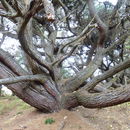More info for the terms:
cone,
seedThe minimum seed-bearing age for Monterey pine is between 5 and 10
years. Maximum seed production beings at 15 or 20 years of age if trees
are open-grown, and later if stands are dense [
11,
25,
35]. Cones are
produced annually, with good cone crops produced every other year [
25].
Mature cones remain attached to the branch. They may remain closed for
several years, depending upon temperature and humidity. Cones open and
release seed during warm, dry periods and close rapidly when temperature
drops and relative humidity increases. This results in a constant but
meager seed rain [
52]. The cones of native populations open
infrequently because their habitat is typically cool and moist.
Seedfall is heaviest in warm, dry years [
35]. Unreleased seed remains
viable for decades. Seeds from cones up to 24 years of age have
germinated; however, germinative capacity appears to fall off with
progressing years [
52]. Seeds can be exposed to a temperature of 203
degrees Fahrenheit (95 deg C) before germination is significantly
reduced [
29]. Seedling recruitment is best on mineral soil [
52].
Details of growth are discussed in the literature [
11].
Monterey pine does not reproduce by sprouting [
14,
35].

